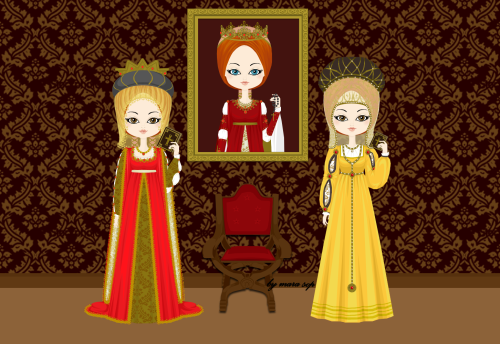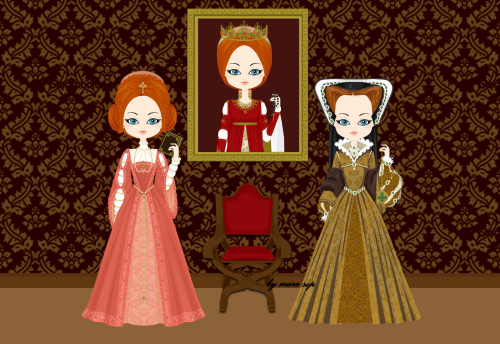#maria of aragon
Maria Of Trastamara. Infanta Of Castile & Aragon Queen Of Portugal. Her Daughter, Isabella Of Aviz, Infanta Of Potugal & Holy Roman Empress.
Post link
My Trastamara’s Girls - Part Two
Newly I posted the Trastamara’s Family Three, and talked a little about the matriarch, Isabella of Castille.
Now I’ll introduce two of her daughters, both queens of Portugal and wives of King Manuel I.
Isabella de Aragon, princess of Asturias and queen of Portugal.

She was the first daughter and heiress of Ferdinand de Aragon and Isabella de Castile, and the beloved first wife of portuguese King Manuel I.
In 1490 Isabella married Afonso, Prince of Portugal, the heir of John II of Portugal. Though it was an arranged marriage, Isabella and Afonso quickly fell in love, and Isabella was grief-stricken when he died in 1491: sent home to her parents by John II, she declared that she would never marry again and would enter a convent. Her parents ignored this, and in 1497 she was persuaded to marry Manuel I of Portugal, Afonso’s uncle and John II’s cousin and successor. She did so on condition that Manuel follow her parents’ religious policy and expel Jews who would not convert to Christianity from his realm. This he duly did. In the same year, Isabella became Princess of Asturias and heiress of Castile following the death of her only brother John and the stilbirth of his daughter.
Was really hard find good images to make her, the only one where she appears in full body, she’s on her back, so to make her headdress I used a drawing of her that certainly is from ten years after the model of the dress.
c. 1485
Maria de Aragon, queen of Portugal

She was the second daughter of Ferdinand de Aragon and Isabella de Castile, and the second wife of portuguese King Manuel I.
As an infanta of Spain, her hand in marriage was very important in European politics. Before her marriage to Manuel I of Portugal, her parents entertained the idea of marrying her off to King James IV of Scotland. This was at a time when her younger sister Catherine’s marriage to Arthur, Prince of Wales, was being planned. Ferdinand and Isabella thought if Maria was Queen of Scotland, the two sisters could keep the peace between their husbands. These plans, however, came to nothing. Her eldest sister Isabella, Princess of Asturias, was the first wife of Manuel I, but her death in 1498 created a necessity for Manuel to remarry. Maria became the next bride of the Portuguese king, reaffirming dynastic links with Spanish royal houses.
Manuel and Maria were married in 1500, and had 10 children, eight of whom reached adulthood, including King John III of Portugal, Holy Roman Empress Isabella of Portugal, and Beatrice, Duchess of Savoy.
c. 1505
In the next post we’ll see the two must famous daughters of Isabella of Castile, Juanna and Catalina.
by mara sop
Post link
My Trastamara’s Girls - Part Six
Ending the line of Trastamara’s queens descendents of Isabella of Castile, we have the daughters of Maria and Catalina (Catherine) of Aragon.
Isabella of Portugal (Maria of Aragon’s Daughter)

Isabella was the second child and eldest daughter of King Manuel I of Portugal and his second spouse, Infanta Maria of Castile and Aragon. She was named after her maternal grandmother, Isabella I of Castile, and her aunt Isabella, Princess of Asturias, who had been her father’s beloved first spouse.
Isabella had 3 children. Phillip II of Spain, the Holy Roman Empress Maria of Portugal and Joanna princess of Portugal.
She died in 1539, so this is a postumos portrait painted 9 years after her death.
And I just realized that I totally forgot of the Holy Roman Empress, the Archduchess Maria of Austria, spouse of Maximilian II, Holy Roman Emperor and King of Bohemia and Hungary, and her daughters Anne and Elizabeth of Austria, both queens. WOW!!! I’ll make her soon. I promise! ;)
Isabella’s portrait is from c. 1548
Maria had another daughter, the infanta Beatrice, married with Charles III, duke of Savoy. But she never was a queen neither her descendents.

Mary Tudor (Catherine of Aragon’s Daughter)

Queen Mary I of England, or Bloody Mary
Mary was the only surviver daughter of Henry VIII and Catalina de Aragon, and a huge catholic person. She became more famous because of her persecution of protestants during her reign than anything else, so she earned the nickname Bloody Mary.
Mary was a precocious child. Throughout Mary’s childhood, Henry VIII negotiated potential future marriages for her. When she was only two years old, she was promised to the Dauphin, the infant son of King Francis I of France, but the contract was repudiated after three years. In 1522, at the age of six, she was instead contracted to marry her 22-year-old first cousin, Holy Roman Emperor Charles V. However, the engagement was broken off within a few years by Charles with Henry’s agreement.
But with the nullification of the marriage of Henry VIII and Catherine of Aragon, Mary was considerated as bastard.
From 1531 until her mother’s death, Mary was often sick with irregular menstruation and depression, although it is not clear whether this was caused by stress, puberty or a more deep-seated disease. She was not permitted to see her mother, who had been sent to live away from court by Henry.
Mary and her first stepmother, Anne Boleyn, detested each other, and she also hate Katherine Howard, but apparently she got along quite well with Jane Seymour, Anne of Cleves and Katherine Parr.
As illegitimate child, Lady Mary loose everything, including her marriages proposals, and only had a new suitor when she was courted by Duke Philip of Bavaria from late 1539, but Philip was Lutheran and his suit for her hand was unsuccessful.
She finally got marriage after being crowned queen. At the age of 37, she married with her cousin Phillip II of Spain, but, but even with several psychological pregnancies, she died childless.

c. 1554
It’s really interesting analize the costumes of the Trastamara Girls to see the versatility of the fashion renaissance. When we think in the renaissance, we automaticaly visualize 3 or 4 especificy outfits, like the mid 1530s Tudor’s fashion, an elizabethan, an italian renaissance, and maybe an iberic style outfit…
And in the House of Trastamara’s fashion we can see the transition between the Middle Ages and the Renaissance even in the 16th century, a huge influence of german renaissance, and of kind of hats, hoods and veils. Is really cool to see it.
by mara sop
Post link



